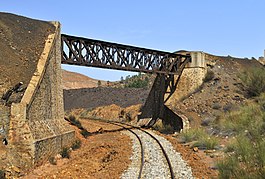Our website is made possible by displaying online advertisements to our visitors.
Please consider supporting us by disabling your ad blocker.
Riotinto Railway
| Riotinto Railway | |
|---|---|
 View of the route under the Gurugú Bridge in 2014 | |
| Overview | |
| Native name | Ferrocarril de Riotinto |
| Locale | Huelva, Spain |
| Transit type | Rail transport |
| Operation | |
| Began operation | 28 July 1875 |
| Ended operation | 8 February 1984 |
| Technical | |
| System length | 83.6 km (51.95 mi) |
| Track gauge | 1,067 mm (3 ft 6 in) |
The Riotinto Railway was a Spanish narrow-gauge railway line, predominantly used for mining and industry, that operated between 1875 and 1984. During this time it became one of the main railways in the province of Huelva, gaining a large fleet of rolling stock.[1]
The railway was built between 1873 and 1875 by the British Rio Tinto Company Limited (RTC),[2] that sought to provide maritime access to the minerals extracted from ore deposits in the Riotinto-Nerva mining basin. For much of its route, the track ran parallel to the course of the Tinto River, although in its last stage it ran alongside the Iberian-gauge Seville-Huelva railway. For over a century, it was one of the most heavily-used mining railways in Spain.[3] Likewise it had a large fleet of cars and engines, to the point of becoming the second largest in the country after the Renfe.[4] The route closed to public traffic in 1984.[5]
After several years the abandoned infrastructure was subject to looting, so in the late 1980s action was taken to recover the historic railway line and return it to service. This work would be carried out in the 1990s, around the time when the popular Tourist Mining Train was introduced.[6] In the 21st century a small 11 km (6.8 mi)-long railway section is kept operational for tourist and recreational purposes. The remaining route has been either abandoned or dismantled.[7]
- ^ Delgado, Campos & Narbona (2009), pp. 24–25
- ^ Flores Caballero (2011), pp. 426–429
- ^ Mojarro Bayo (2010), p. 395
- ^ Delgado et al. (2013), p. 90
- ^ Rábano, Manteca & García (2003), pp. 436, 438
- ^ Delgado, Campos & Fiñana (2007), pp. 23–26
- ^ Amoluc (2012), p. 33
Previous Page Next Page


